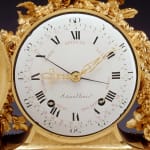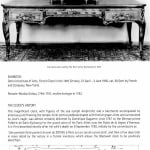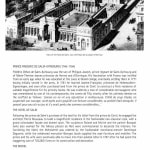
The clock when sold by The Hon. Victor Rothschild 1937.

View of the hôtel de Salm, now the Palais de la Légion d'Honneur.
Renacle-Nicolas Sotiau
Further images
Provenance
Almost certainly ordered and delivered by Dominique Daguerre to the German prince Frédéric Othon de Salm-Kyrbourg (1748-94) for the grand salon of the hôtel de Salm, Paris, circa 1787
Deceased sale of the prince de Salm’s effects in Paris 1796, lot 464
The marchand Villemain, purchased from the above sale; his sale 20th August 1798, lot 46
Baron Lionel de Rothschild (1808-79), 148 Piccadilly, London, thence by descent to: The Hon. Victor Rothschild, later 3rd Lord Rothschild, 148 Piccadilly, London, his sale Sotheby’s London, 19th April 1937 lot 335 (illustrated in the catalogue) H.M. Lee, purchased from the above sale French and Company, New York, by 1956.
Exhibitions
Detroit Institute of Arts, “French Taste in the 18th Century”, 27th April – 3rd June 1956, cat. no. 56 (lent by French and Company, New York).
Literature
Hans Ottomeyer and Peter Pröschel, “Vergoldete Bronzen”, 1986, p 296, pl. 4.18.1, illustrating a very similar clock with case by François Rémond and movement by Lepine in the Musée du Louvre, Paris. Cedric Jagger, “Royal Clocks”, 1983, p. 153, pl. 210, illustrating a very similar clock in the British Royal Collection.
A highly important and very beautiful Louis XVI gilt and patinated bronze and white marble mantel clock by the eminent horloger Renacle-Nicolas Sotiau, signed on the white enamel dial Sotiau à Paris. The dial with outer Arabic numerals for the minutes, red Arabic numerals for the 31 days of the month, Roman numerals for the hours and inner red names of the days in the week, with a very fine pair of pierced gilt brass hands and blued steel pointers for the month and week. The magnificent case attributed to the celebrated bronzier François Rémond, surmounted by Jupiter’s eagle and hung with floral and acorn swags, above a rectangular base decorated with cherubs playing with a goat, flanked on the left by the sea nymph Amphitrite, wife of Neptune holding a trident and embracing a cherub and to the right by a female Bacchante with a cherub, both draped with a festive grape vine, the inverted breakfront panelled plinth centred by a mask and flanked by cherubs and berried acanthus scrolls, on turned gadrooned feet
Paris, date circa 1785
Height 72, width 72 cm, depth 25.5 cm.
This magnificent clock was almost certainly delivered in about 1787 by the marchand-mercier, Dominique Daguerre to the German prince de Salm-Kyrbourg to decorate the grand salon of his newly built Paris hôtel, now the Palais de la Légion d’Honneur. The prince was the son of Philippe-Joseph, prince régnant de Salm-Kyrbourg and of Marie-Therèse-Jeanne princesse de Hornes and d’Overisque. The young prince’s fascination with France was instilled from an early age when he was educated at the Louis le Grand College; he then served in the army and settled in France in 1771. Soon after his marriage to Jeanne-Françoise, princesse de Hohenzollern-Sigmaringen in 1781 he purchased land from the prince de Conti to construct a Parisian residence of suitable magnificence for his princely tastes. The prince, who was known for his great extravagance subsequently spent the staggering sum of 700,000 livres on its construction and decoration. He employed the architect Pierre Rousseau to build a huge residence in the fashionable Neo-classical style, with a grand colonnaded façade and domed salon, where the clock was subsequently placed for all to admire.
The sculptors Roland and Moitte and the painter Bosquet (who also worked for the Menus plaisirs Du Roi) completed the interior. The ébénisterie furnishing and many of the artifacts were ordered by Daguerre while the seating and mobilier were supplied by the celebrated menuisier Georges Jacob. The prince and his wife were eventually able to move into their palatial residence in 1787.
The clock was recorded by the commissaire in a list of effects made shortly after the death of the prince’s wife on 9th September 1790. It then featured again, in the inventory made after the prince’s own death when he, like many French aristocrats, was executed at the guillotine during the reign of Terror. His residence and all the furnishings were subsequently sold in a Paris auction in 1796, when the clock was sold to the marchand Villemain for 600,000 livres en assignats (the currency used during the Revolutionary period). Two years later Villemain, who combined his activities as a banker with those of a speculator, was himself forced to sell his collection due to financial difficulties. Thus the clock was sold once more by auction, 20th August 1798, lot 46. The clock then disappeared from sight until 1937 when it featured in the celebrated sale of art and effects belonging to the Hon. Victor Rothschild, whose magnificent collection had predominantly been assembled by Baron Lionel de Rothschild.
At about the same time that the clock was being created, Dominique Daguerre sent a drawing of the same model (with differing plinth, an eagle bearing Jupiter’s thunderbolt and antique flutes in place of laurels) to Marie-Antoinette’s sister, Marie-Christina of Sachsen-Teschen (cited in J. Harris et al., “Buckingham Palace”, 1988, p. 164). The present clock case compares very closely with three others, all housed in extremely important collections, namely, the Louvre, the Metropolitan Museum and the British Royal Collection. The latter was recorded in the collection of the Prince Regent, later King George IV of England (1762-1830) and was housed in the Throne Room Ante-Chamber at his London residence Carlton House. It may have originally housed a Lepine movement but like many in the same royal collection was later replaced by B. L. Vulliamy (d. 1854). Another similar model with its original Lepine movement still intact is now housed in the Musée du Louvre and like the model in the British Royal Collection has the eagle facing in the opposite direction. A third comparable model can be found in the Esmerian collection in the Metropolitan Museum, New York.







